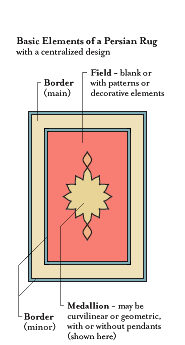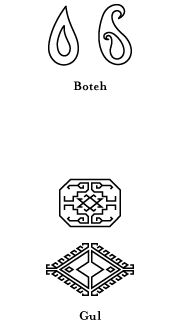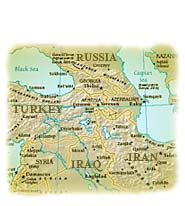Rug Terminology

Abrash – A change in the color of a rug due to differences in the wool or dye batch. The color and change runs across the rug, and is most likely to occur at the top.
Art Deco – A design style developed in the 1920s and ’30s in Europe and the U.S. Typical motifs include geometric shapes, stylized animals, foliage and sun rays.
Aubusson – A style of flat-woven rug originally created in the French village of Aubusson, a center for the production of tapestries and furniture coverings since the 16th century. Aubusson rugs are known for their floral and Chinoiserie patterns.
Bokhara or Bukhara – Named for their city of origin in Western Uzbekistan, Bokhara rugs have small, repeating geometric designs, including the elephant foot and octagonal “gul” motifs in greens, reds, whites and browns. Bokhara rugs are also referred to as Beshir rugs, Turkoman rugs or Samarkand rugs.
Boteh – A pear-shaped figure often used in Oriental rug designs, characteristic of the paisley pattern. The boteh may represent a leaf, bush or a pinecone.
Chain Stitch – A crochet stitch used in rug construction that consists of successive loops to lock the final weft in place at the end of a rug.
Field – The part of a rug’s design surrounded by the border. The field may be blank or contain medallions or an overall pattern.
Fringe – Warps extending from the ends of a rug which are treated in several ways to prevent the wefts and knots from unraveling. Note that not all Oriental rugs have fringe.
Gul – A medallion either octagonal or angular in shape, used in Pakistani designs. It is often repeated to form an overall pattern in the field.
Heriz or Herez – An Oriental rug made in northwestern Iran and characterized by strong angular design and an ivory background.
Kerman or Kirman – An Iranian province which produces rugs characterized by elaborate fluid designs and soft colors.
Medallion – The large enclosed portion of a design, usually in the center. Typical shapes are diamonds, octagons and hexagons.
Persian Knot – Also known as the Senneh Knot, and used in India, Pakistan, Central and Western Iran and China, it is looped around one thread with only a half-turn around the other thread.
Sarouk – A village near Hamadan in western Iran, known for carpets of fine compact weave, mellow colors and fluid medallion designs.
Savonnerie – La Savonnerie, a carpet factory, was established in 1628 on the site of a former soap factory at Chaillot, near the Seine in Paris. Savonnerie rugs typically feature a center medallion and peripheral border and are often large in size. Motifs are often carved in the rug, adding texture.
Tabriz – A city in northwestern Iran, known for rugs with a firm wool pile and medallion design, usually tied with a Senneh or Persian knot.
Turkish Knot – Also known as the Ghiordes Knot, and used in Turkey, Western Iran and the Caucasus, it is tied around two adjacent warp threads.
Warp – Comprising the structure of the rug, parallel warp yarns run the length of the rug, and are interlaced with wefts.
Weft – The yarns woven horizontally through the warps.

